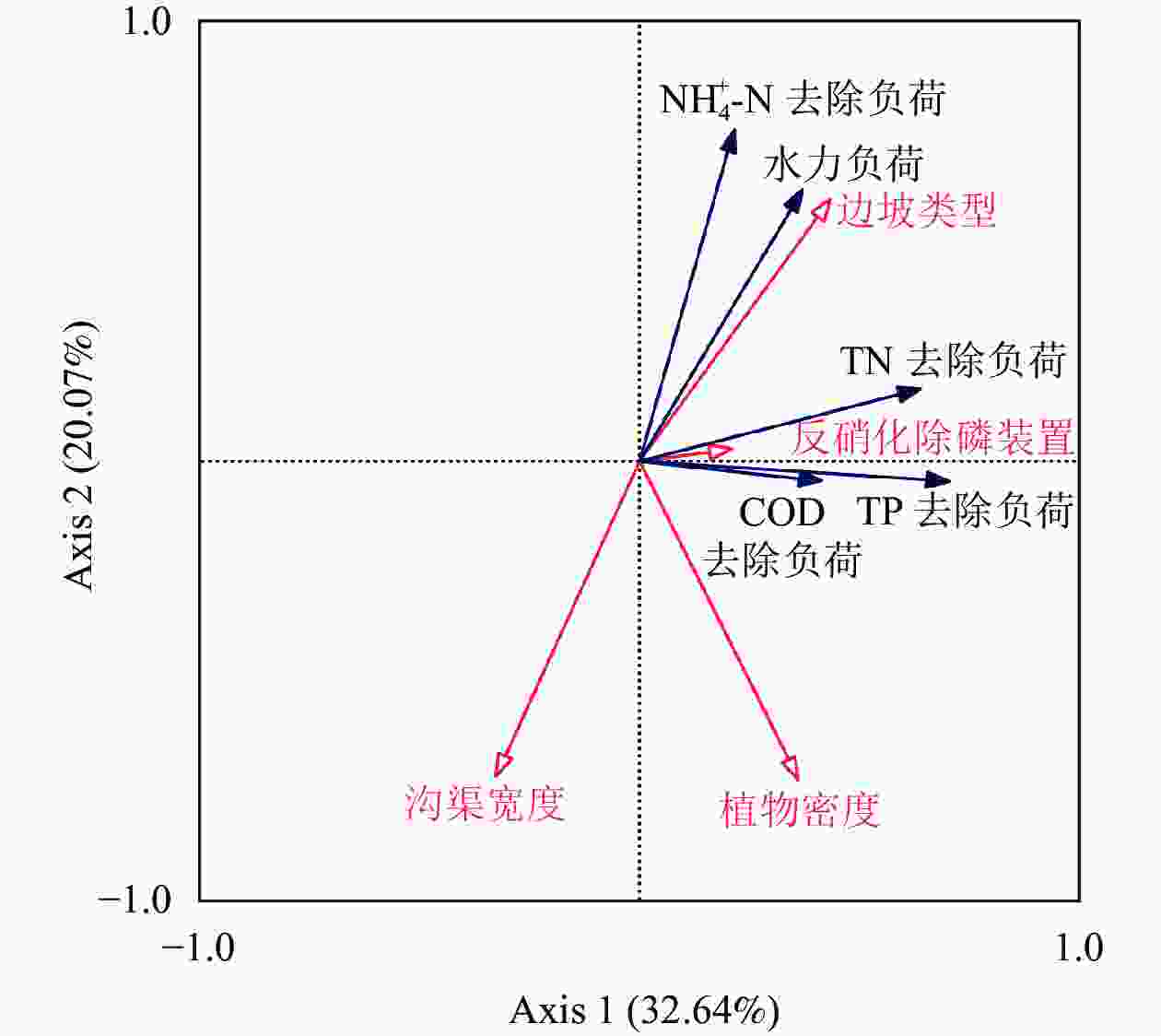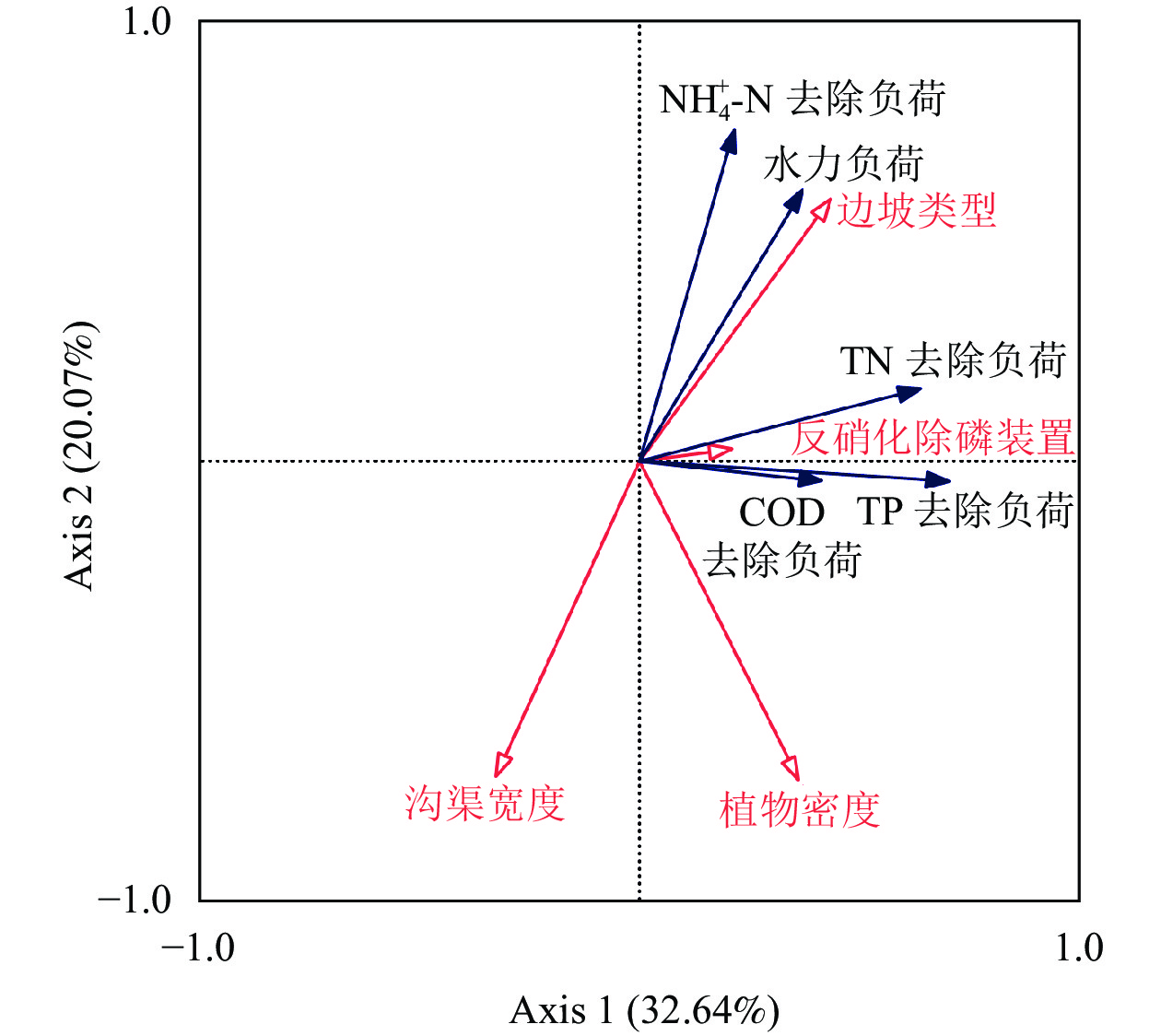-
农田氮磷养分在强降雨期间易随地表径流进入农田排水沟渠,再沿着沟渠迁移入江河湖泊中[1]。《第2次全国污染源普查公报》显示:农业面源污染物排放对水体影响依然不容忽视,其中总氮(TN)年排放量为141.49万t、铵态氮(NH4+-N)年排放量为21.62万t、总磷(TP)年排放量为21.20万t、化学需氧量(COD)年排放量为
1067.13 万t,分别占总排放量的46.52%、22.44%、67.22%和49.77%。国际上对农业面源污染的研究和治理通常实施“最佳管理措施”(BMPs),包括养分管理、河流改造、生态拦截、畜禽粪污清洁还田等治理手段。国内则在最佳管理措施的基础上进一步形成了“源头减量-过程阻断- 生态修复-养分再利用”(“4R”理论)的治理思路[2]。可见,在2种治理理念中拦截阻断技术都是重要的组成部分。沟渠是农田系统的重要组成部分,可以在非农田区域为水生或陆生动植物提供栖息场所与食物来源,是维护农田生物多样性的关键[3]。生长在沟渠内的植物,可以固持营养物质[4]。最初的研究主要集中在农田沟渠对农田排水中农药的净化作用[5−6],之后逐渐聚焦到对农业面源污染物的去除作用[3−4, 7−9]。生态沟渠技术利用沟渠在农田与河塘湖库之间水流“连通器”的地理优势,通过在渠内种植大量的优势水生植物,包括沉水植物、挺水植物、护坡植物和沟堤蜜源植物等,提高水生植物密度,兼顾污染净化、生态链恢复、植物季相、景观优化等因素;同时,在渠内建造反硝化除磷装置等设施,通过吸附材料,促进生物膜形成,强化净化作用;改造泥质边坡为生态边坡,增加边坡粗糙度,延长水力停留时间。通过以上改造形成的生态沟渠,加强了沟渠系统的生态拦截能力[9−10],因其不需额外占用耕地等优势,是应用比较广泛的农业面源污染过程拦截技术。
已有不少研究验证了生态沟渠对总氮、铵态氮、总磷、化学需氧量等农业面源污染物的拦截效果,研究地区分布江苏[11]、上海[12]、四川[13]、陕西[14]、湖南[15]、珠三角[16]、东北三江平原[17]、滇池流域[18]等地。此外,胡博[19]通过成本收益分析法评价了农田生态沟渠的环境经济效益,认为生态沟渠具有可实施性与较好的经济性,可以作为防控农田面源污染的补偿机制与政策推荐。因而,农田生态沟渠是目前应用较广、效果较好的农业面源污染过程拦截技术,再结合景观工程,兼具了“氮磷拦截、生态修复、洁净排放、田园景观”四大功能。2018年起,浙江省在全省域建设农田生态沟渠系统。截至2021年底,浙江省已建成生态沟渠510条,沟渠总长度达592 km,覆盖农田面积2.4万hm2[20]。但是,目前有关浙江省推广建设生态沟渠的水质净化效果的相关理论成果较少,尤其是还没有关于在统一建设规范指导下[21]的生态边坡、水生植物、反硝化除磷装置等建设,与生态沟渠对农业面源污染物去除效果的相关性研究成果报道。因此,本研究选择了浙江省推广建设的6条农田生态沟渠,监测在降雨后生态沟渠中的水质变化情况,分析生态沟渠对农业面源污染物的拦截效果,并对生态边坡等相似建设内容与各污染物去除负荷进行相关性分析,为进一步推进生态沟渠建设提供科学依据,实现精准、科学治污。
-
本研究选取的浙江省6条典型生态沟渠(表1),均在2020年上半年建成并投入运行,分别位于杭州市桐庐县江南镇莲塘村(桐庐沟渠)、杭州市临安区太阳镇沈家村(临安沟渠)、杭州市建德市钦堂乡蒲田村(建德沟渠)、金华市东阳市六石街道吴良村(东阳沟渠)、金华市义乌市毛店镇乔溪村(义乌沟渠)、绍兴市诸暨市安华镇三联村(诸暨沟渠)。
沟渠 位置 边坡类型 反硝化除磷装置数量/个 水生植物覆盖度/% 沟渠宽度/ m 桐庐沟渠 杭州市桐庐县江南镇莲塘村 生态边坡 6 30 0.85~0.95 临安沟渠 杭州市临安区太阳镇沈家村 三面光 8 32 2.40 建德沟渠 杭州市建德市钦堂乡蒲田村 三面光 6 42 0.55 东阳沟渠 金华市东阳市六石街道吴良村 生态边坡 7 30 2.40~3.00 义乌沟渠 金华市义乌市毛店镇乔溪村 生态边坡 8 40 2.20 诸暨沟渠 绍兴市诸暨市安华镇三联村 三面光 6 60 0.85 Table 1. Description of sampling sections of 6 ecological ditches
6条生态沟渠均位于浙西中低山丘陵区的水稻Oryza sativa种植区域,群山耸峙间为狭小河谷平原,山地与平原间则丘陵错落,适合水稻生长。临安沟渠为稻鳖共生生产模式;桐庐沟渠、东阳沟渠与诸暨沟渠的沟渠落差不明显,水流较为缓和; 建德沟渠位于山脚,生态沟渠落差较为明显,沟渠内水流较快;义乌沟渠位于山区稻蛙共生养殖基地,沟渠落差明显。表1记录了采样渠段概况,其中边坡类型分为生态边坡(生态砖坡面)与三面光(混凝土坡面),反硝化除磷装置包括底泥捕获井、氮磷去除模块、生态透水坝[22]。桐庐沟渠、东阳沟渠、义乌沟渠等3条沟渠为生态边坡,水生植物覆盖率分别为30%、30%、40%,沟渠宽度分别为0.85~0.95、2.40~3.00、2.20 m;临安沟渠、建德沟渠、诸暨沟渠等3条沟渠为三面光边坡,水生植物覆盖率分别为32%、42%、60%,沟渠宽度分别为2.40、0.55、0.85 m。
-
一般认为:在降雨产生农田表面径流并进入沟渠时,生态沟渠起到对污染物的拦截作用,因而降雨期间是监测沟渠净化能力的关键时期[12]。本次取样时间为2021年9月6—10日,连续5 d,每天采集1次,分别记为T1、T2、T3、T4、T5。采样期间浙江省内以阴天为主,夜间普降阵雨,桐庐沟渠、临安沟渠、建德沟渠、东阳沟渠、义乌沟渠、诸暨沟渠降水总量分别为58.82、26.42、34.90、8.59、11.32、32.63 mm (数据来自国家气象科学数据中心)。沟渠内均有农田排水流入和明显的水流流动。生态沟渠取样长度控制在250 m,并保证采样沟渠段上游有农田排水口,且无分支沟渠进水。在取样渠段沿水流方向设置5个采样点(图1),分别记为P1、P2、P3、P4、P5,覆盖沟渠进水口(农田排水出口)、水生植物前后、反硝化除磷装置前后,测定采样点的横截面积与流速。
-
测定采集水样中的总氮、铵态氮、化学需氧量与总磷质量浓度,同时测定采样点流速并量取采样点横截面积。水样中的铵态氮质量浓度采用水杨酸分光光度法测定;总氮采用碱性过硫酸钾消解-紫外分光光度法测定;总磷采用过硫酸钾氧化-钼锑抗分光光度法测定;化学需氧量采用重铬酸盐法测定;流速和采样点横截面积分别采用浮标法和水道断面测量法测定。
-
通过计算监测渠段首段与末端的污染物质量浓度,计算各污染物去除率情况,评估沟渠的拦截能力。各污染物去除率计算如下:
式(1)中:η为污染物去除率(%),Cin和Cout分别为沟渠起始和末端污染物质量浓度(mg·L−1)。
通过计算监测渠段的流速与横截面积,计算水力负荷(Pw),即单位时间内通过单位面积的水体。从而计算进水负荷(Pin)及去除负荷(PL)。公式如下:
式(2)~(4)中:Q为流量(m3·d−1),由流速与横截面积相乘得到,S为沟渠横截面积(m2)。
对不同沟渠的总氮、铵态氮、化学需氧量与总磷去除率进行方差分析及显著性测验(最小显著性差异法),采用Excel 2010和Origin 2020对数据进行分析、制图。
-
如表2所示:监测期间6条生态沟渠对总氮的平均去除率为18.31%,其中义乌沟渠对总氮的去除率高于其他沟渠,达到82.41%,其他沟渠对总氮的平均去除率为0.75%~7.76%。
沟渠名称 面源污染物去除率/% 总氮 铵态氮 总磷 化学需氧量 桐庐沟渠 7.45±10.87 b 68.64±9.67 a −4.55±10.31 b 15.04±15.30 a 临安沟渠 5.68±8.39 b 14.40±7.30 b 13.76±2.46 b 17.21±23.29 a 建德沟渠 7.76±8.17 b 33.95±12.41 b 0.08±8.56 b 13.72±15.99 a 东阳沟渠 5.82±5.87 b 21.73±22.93 b −6.19±23.55 b 25.49±10.26 a 义乌沟渠 82.41±1.11 a 80.24±4.01 a 62.47±31.14 a 44.00 ±25.91 a 诸暨沟渠 0.75±15.71 b 13.48±6.17 b 15.37±43.16 ab 28.37±26.82 a 平均 18.31±30.49 38.74±28.96 13.49±32.57 23.97±21.48 说明:数据为平均值±标准差。不同小写字母表示不同沟渠间差异显著(P<0.05)。 Table 2. Average removal rates of non-point source pollutants in 6 ecological ditches
6条生态沟渠对铵态氮的平均去除率为38.74%,普遍高于总氮与总磷。桐庐沟渠和义乌沟渠的铵态氮平均去除率显著高于其他沟渠(P<0.05),达65.00%以上。其他3条沟渠铵态氮去除率之间无显著差异。6条生态沟渠对总磷的平均去除率较低,为13.49%。义乌沟渠的总磷平均去除率显著高于其他沟渠(P<0.05)。6条生态沟渠对化学需氧量的平均去除率为23.97%,沟渠化学需氧量去除率之间无显著差异。
进一步分析各沟渠农业面源污染物(总氮、铵态氮、总磷、化学需氧量)的进水质量浓度、出水质量浓度与去除率随时间变化情况(图2)可知:各生态沟渠进水中的主要污染物质量浓度均不同。临安沟渠以总氮与铵态氮污染物为主,并且始终保持较高的污染水平,总氮高达19.0 mg·L−1,其他生态沟渠的总氮也均高于地表水Ⅴ类水标准。东阳沟渠前3 d进水的铵态氮质量浓度较高,在T2时化学需氧量达到最高。义乌沟渠则在T2与T5时进水的总磷质量浓度较高,达0.3 mg·L−1以上。

Figure 2. Variation of influent, effluent concentrations and removal rates of agricultural non-point source pollution in six ecological ditches
临安沟渠对总氮的去除率在T1、T2时达到10%,总氮出水质量浓度依然保持较高水平;义乌沟渠对总氮、铵态氮、总磷的去除率在采样期间均保持在80%左右。桐庐沟渠相较于其他沟渠,对铵态氮去除率在采样区间均保持较高水平。可见,不同沟渠各污染物的进水负荷以及沟渠对污染物的去除率均存在较大差异。
-
由图3可知:义乌沟渠对总氮、铵态氮、总磷、化学需氧量去除负荷随着进水负荷的增大而增大。桐庐沟渠对总氮、铵态氮、化学需氧量去除负荷与其进水负荷,临安沟渠对总磷、化学需氧量去除负荷与其进水负荷,诸暨沟渠对总磷去除负荷与其进水负荷均有较好的线性关系(P<0.05),说明沟渠对相应地污染物表现出较好的去除能力,能够抵抗径流产生期间的污染负荷波动。但是也有部分沟渠的去除负荷与进水负荷的决定系数(R2)较低,说明沟渠去除负荷除了受到进水负荷影响,还受到其他因素的影响。此外,污染物进水负荷处于较低水平,污染物的去除负荷与其进水负荷的线性关系越差。
-
图4中红色箭头为生态沟渠建设中的主要环节或模块,蓝色箭头为水力负荷和本研究需评估的污染物负荷指标。若蓝色箭头与红色箭头夹角较小,箭头长度越长,说明两者相关性强,反之则说明相关性弱。可见:总氮、铵态氮去除负荷与边坡类型、反硝化除磷装置数量有较好的正相关,生态边坡赋值为1.0,三面光赋值为0.5,表明生态边坡有利于总氮、铵态氮去除;总氮、铵态氮去除负荷与植物密度相关性弱,与沟渠宽度呈较好的负相关,表明较窄的沟渠对总氮、铵态氮去除较好。总磷、化学需氧量去除负荷与植物密度、反硝化除磷装置数量正相关性较好,与边坡类型、沟渠宽度相关性弱,表明提高植物密度、反硝化除磷装置数量可以促进沟渠对总磷、化学需氧量的去除。
-
污染物去除率是评估生态沟渠净化效果普遍采用的指标[22−25]。文献中有关生态沟渠对总氮的去除率为9.52%~88.86%[9, 11−14, 26],总磷去除率为19.94%~70.00%[11−14, 26],铵态氮去除率为44.50%~77.80%[11−13, 16],也有沟渠在添加Fe2+与碳源后对总氮、铵态氮、总磷的72 h去除率均超过80.56%[17]。江苏镇江氮磷拦截沟渠的化学需氧量去除率达46.9%[24]。本研究中,义乌沟渠对总氮平均去除率与文献记载相近,其他沟渠对总氮的平均去除率仅在10%左右,接近文献记载最低水平;桐庐沟渠、义乌沟渠与建德沟渠的铵态氮平均去除率接近文献记载,其他3条沟渠铵态氮去除率低于文献记载。本研究生态沟渠对总磷、化学需氧量的平均去除率低于文献记载,原因之一可能是文献中的一些沟渠在建设完工初期进行了水质监测,建设初期沟渠水泥边坡、透水坝中的吸附材料均具有较强的吸附作用[16, 26],而本研究中生态沟渠均已建设完成1 a以上;也有文献采用的是累计去除率[9, 27],本研究采用的是监测时刻的平均去除率;另外,文献中的一些生态沟渠,特别是室内模型实验为植生型沟渠,通过种植高密度水生植物实现净化作用[10, 12],而实际生态沟渠中,要兼顾植物种植面积和美观度。这些可能是导致去除率低于文献记载的主要原因。
相较于污染物去除率,污染物去除负荷的度量不仅计入了污染物质量浓度的变化,还兼顾了水力负荷以及沟渠系统的横截面积,更能反映沟渠系统的去污能力。王迪等[15]在采用进水口和出水口污染物质量浓度变化计算去除率的基础上,将沟渠流量变化用于计算沟渠对污染物的拦截率,并将去除率与拦截率进行对比,结果几乎一致。刘福兴等[28]也采用生态沟渠对单位面积的水体污染物的去除量来衡量沟渠净化效果。因此,本研究也着重研究了各条沟渠对污染物的去除负荷与进水负荷的线性关系,并结合去除率进行分析。
义乌沟渠、桐庐沟渠对总氮、铵态氮表现出较高的去除率,并且去除负荷与总氮、铵态氮进水负荷呈线性关系,说明沟渠可以抵抗径流产生期间的污染负荷波动[29]。通过冗余分析,推测可能原因是义乌沟渠、桐庐沟渠均为生态边坡并且宽度较窄,因而增加了边坡粗糙度以及水流与边坡的接触面积,延长了水力停留时间。王岩等[27]研究表明:三面光沟渠主要由沉积物和混凝土板材的吸附作用去除污染物,只能在建设初期表现出较好的拦截效果。此外,三面光沟渠流速较快,污染物无法在生态沟渠中滞留,有限的水力停留时间限制了生态沟渠的净化能力。赫贝贝等[16]研究表明:多孔砖生态沟渠对水体铵态氮、${\mathrm{NO}}_3^- $、总氮、总磷和化学需氧量的平均去除率较高。虽然东阳沟渠也为生态边坡,但因渠道较宽,可能削弱了一定部分生态边坡带来的积极作用。
诸暨沟渠表现出较好的总磷去除率,并且去除负荷也与总磷进水负荷呈线性关系。通过冗余分析,推测是因为诸暨沟渠植物密度高达60%,是其他沟渠植物密度的1.5倍以上。MOORE等[4]研究发现:相较于无植物沟渠,有植物沟渠对各形态磷的去除能力更稳定。植物也可以有效促进污染物的沉积[30]。研究发现:在长有植物的沟渠水中,总固体中含有28%可悬浮沉积物,而在无植物沟渠水中这一指标达95%以上。这是因为植物可以有效增加排水通道的摩擦阻力与粗糙度,从而延长水力停留时间[31−32]。但是本研究中,沟渠植物密度与铵态氮去除负荷呈现负相关,与总氮去除负荷相关性不强,这与部分文献[4, 33]结果不一致,可能原因是生态沟渠中的植物量是有限的,进入沟渠的氮总量超过植物吸收氮量的阈值,会导致生态沟渠对氮的去除率也相应下降[27]。此外,当水力停留时间较短,沟渠壁对氮的吸附作用占主导,当水力停留时间较长,沟渠中的植物对氮的吸收占主导地位[27]。王迪等[15]研究认为:水生植物密度可以提升沟渠对氮素的去除能力,但是较短的水力停留时间会导致氮素去除率的降低,侧面说明本研究所调查沟渠的水力停留时间较短。
本研究中6条生态沟渠均设置有相当数量的反硝化除磷装置。本研究发现:反硝化除磷装置数量与总氮、铵态氮、总磷和化学需氧量去除负荷呈较好的正相关关系。反硝化除磷装置是浙江省推广生态沟渠的关键技术环节。沟渠中的反硝化除磷装置通过形成微生物膜,起到减缓水流、延长水力停留时间的作用,使得流水携带的颗粒物质和养分等得以沉淀,提高对污染物的拦截效果,促进沟渠内植物及附着其根系的微生物对氮磷的吸收 [24, 34]。
-
本研究连续监测了在浙江省推广应用的生态沟渠的水质。监测结果表明:生态沟渠对总氮、铵态氮、总磷、化学需氧量的平均去除率分别为18.31%、38.74%、13.49%、23.97%。不同沟渠各污染物的进水负荷以及沟渠对其去除率均存在较大差异,其中污染物进水负荷与去除负荷相关性较强,采用生态边坡、反硝化除磷装置对总氮、铵态氮去除作用强,增大植物密度与设置反硝化除磷装置对总磷、化学需氧量去除作用较强。在后续浙江省生态沟渠建设中,应加大水质样本监测力度,进一步增加生态沟渠各指标与污染物去除效果的相关性分析,为后续生态沟渠推广应用提供数据支持。
Removal effect of ecological ditches on agricultural non-point source pollutants in Zhejiang Province
doi: 10.11833/j.issn.2095-0756.20240212
- Received Date: 2024-03-04
- Accepted Date: 2024-08-24
- Rev Recd Date: 2024-08-14
- Available Online: 2024-11-20
- Publish Date: 2024-11-20
-
Key words:
- ecological ditch /
- agricultural non-point source pollution /
- ecological slope /
- denitrification phosphorus removal devices /
- plant density
Abstract:
| Citation: | YANG Xubin, SHAO Jianjun, YING Shanshan, et al. Removal effect of ecological ditches on agricultural non-point source pollutants in Zhejiang Province[J]. Journal of Zhejiang A&F University, 2024, 41(6): 1233-1241. DOI: 10.11833/j.issn.2095-0756.20240212 |













 DownLoad:
DownLoad:


